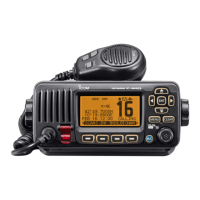
Do you have a question about the Icom IC-M423 and is the answer not in the manual?
| Brand | Icom |
|---|---|
| Model | IC-M423 |
| Category | Transceiver |
| Language | English |
Crucial instructions and advice for safe and effective transceiver use.
Explains key terms like WARNING, CAUTION, and NOTE used in the manual.
Step-by-step guide for distress calls via Channel 16.
Procedure for distress calls using Digital Selective Calling on Channel 70.
RF exposure compliance requirements and operator responsibilities.
Explains how the Maximum Permissible Exposure radius is estimated.
Warnings about power connection, polarity, and cable modification.
Precautions on temperature, sunlight, placement, and compass interference.
Guidelines for cleaning, modification, heat, and waterproof protection.
Rules for call priorities, monitoring Channel 16, and distress call legality.
Guidelines on using overheard information and prohibited language.
Requirements for ship station and operator licenses.
Identification and function of keys on the transceiver's front panel.
Explanation of icons and readouts on the transceiver's display.
Description of the speaker microphone and its operational keys.
How softkey functions are assigned and selected via the menu.
Guide to programming the Maritime Mobile Service Identity (MMSI) code.
How to select operating channels and call channels.
Procedures for receiving signals and transmitting messages.
How to program custom call channels for quick recall.
How to assign custom names to channels.
How to enable or disable the microphone lock feature.
How to adjust audio volume and squelch levels.
How to adjust backlight and activate water draining function.
Explanation of Priority and Normal scan modes.
How to designate channels as favorites for scanning.
Steps to initiate a scan operation.
Explanation and operation of Dualwatch and Tri-watch monitoring functions.
How to program, edit, and delete individual and group DSC addresses.
How to manually input ship's position and UTC time for distress calls.
How to handle incoming distress, group, and other DSC calls.
How to access and manage received and transmitted DSC call logs.
Configuration options for DSC features like acknowledgments, data output, and alarms.
How to use the intercom function with an optional microphone.
How to use external speaker output and public address announcements.
How to activate the horn function.
Overview of navigating and operating the menu screens for configuration.
List and reference of all items available in the menu screens.
Settings for scan types, timers, channel groups, and watch modes.
Settings for display, audio, keys, timers, and noise cancellation.
Diagram and explanation of all external connections for power, data, and audio.
How to track down and replace a blown fuse.
Instructions for cleaning the transceiver and a list of included accessories.
Instructions for mounting the transceiver using the supplied bracket or flush mount.
Instructions for installing the microphone and its cable.
Detailed technical specifications of the transceiver's performance and features.
List and description of optional accessories available for the transceiver.